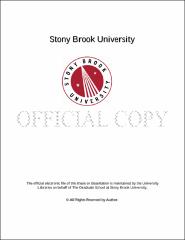| dc.identifier.uri | http://hdl.handle.net/11401/76707 | |
| dc.description.sponsorship | This work is sponsored by the Stony Brook University Graduate School in compliance with the requirements for completion of degree. | en_US |
| dc.format | Monograph | |
| dc.format.medium | Electronic Resource | en_US |
| dc.language.iso | en_US | |
| dc.publisher | The Graduate School, Stony Brook University: Stony Brook, NY. | |
| dc.type | Dissertation | |
| dcterms.abstract | In this dissertation we study quantum field theories with extended supersymmetry in four and three dimensions. In <italic>d=4</italic> we study <italic>N=2</italic> supersymmetric theories using projective superspace formalism extensively. We discover the full non-Abelian action for super Yang-Mills (SYM) theory in projective superspace by studying its relation to harmonic superspace under a suitable Wick rotation of the latter's internal two-dimensional sphere. We also show that a Chern-Simons action for SYM in ‘ full‘ <italic>N=2</italic> superspace can be written down that reproduces both the harmonic and projective SYM actions. The projective formalism allows simplifications in computing Feynman supergraphs because the <italic>N=2</italic> rules imply simpler <italic>D</italic>-algebra than the <italic>N=1</italic> case. Also, integrals over its one-dimensional internal space are simpler to handle than the two-dimensional counterparts in the harmonic case. Furthermore, these calculations are simplified drastically in background field formalism and to construct it in projective formalism, we have to choose different representations for quantum and background fields. This also means that the standard power counting arguments are applicable and finiteness beyond 1-loop for <italic>N=2</italic> SYM becomes manifest. We then study the hyperkähler moduli space of <italic>N=2</italic> SYM compactified on a circle. Recently, it was shown that the Darboux coordinates on the moduli space are an efficient description of the hyperkähler metric and we give a simple construction of the integral equation describing these coordinates using projective superspace. We apply this result to study the moduli space of <italic>d=5</italic> <italic>N=1</italic> SYM compactified on a torus and we obtain results in agreement with the literature. Lastly, in <italic>d=3</italic> we study the free energy of <italic>N=3</italic> Chern-Simons theories associated with affine <italic>ADE</italic> quivers and conjecture a general expression for free energy of <italic>D<sub>n</sub></italic> quivers. Through the AdS/CFT correspondence, this leads to a prediction for the volume of certain class of tri-Sasaki-Einstein manifolds. As a consistency check of our expression, we add massive fundamental flavour fields and verify that the free energy decreases in accordance with F-theorem once they are integrated out. | |
| dcterms.abstract | In this dissertation we study quantum field theories with extended supersymmetry in four and three dimensions. In <italic>d=4</italic> we study <italic>N=2</italic> supersymmetric theories using projective superspace formalism extensively. We discover the full non-Abelian action for super Yang-Mills (SYM) theory in projective superspace by studying its relation to harmonic superspace under a suitable Wick rotation of the latter's internal two-dimensional sphere. We also show that a Chern-Simons action for SYM in ‘ full‘ <italic>N=2</italic> superspace can be written down that reproduces both the harmonic and projective SYM actions. The projective formalism allows simplifications in computing Feynman supergraphs because the <italic>N=2</italic> rules imply simpler <italic>D</italic>-algebra than the <italic>N=1</italic> case. Also, integrals over its one-dimensional internal space are simpler to handle than the two-dimensional counterparts in the harmonic case. Furthermore, these calculations are simplified drastically in background field formalism and to construct it in projective formalism, we have to choose different representations for quantum and background fields. This also means that the standard power counting arguments are applicable and finiteness beyond 1-loop for <italic>N=2</italic> SYM becomes manifest. We then study the hyperkähler moduli space of <italic>N=2</italic> SYM compactified on a circle. Recently, it was shown that the Darboux coordinates on the moduli space are an efficient description of the hyperkähler metric and we give a simple construction of the integral equation describing these coordinates using projective superspace. We apply this result to study the moduli space of <italic>d=5</italic> <italic>N=1</italic> SYM compactified on a torus and we obtain results in agreement with the literature. Lastly, in <italic>d=3</italic> we study the free energy of <italic>N=3</italic> Chern-Simons theories associated with affine <italic>ADE</italic> quivers and conjecture a general expression for free energy of <italic>D<sub>n</sub></italic> quivers. Through the AdS/CFT correspondence, this leads to a prediction for the volume of certain class of tri-Sasaki-Einstein manifolds. As a consistency check of our expression, we add massive fundamental flavour fields and verify that the free energy decreases in accordance with F-theorem once they are integrated out. | |
| dcterms.available | 2017-09-20T16:51:01Z | |
| dcterms.contributor | Siegel, Warren | en_US |
| dcterms.contributor | Nieuwenhuizen, Peter | en_US |
| dcterms.contributor | Herzog, Chistopher | en_US |
| dcterms.contributor | Tsybychev, Dmitri | en_US |
| dcterms.contributor | Khuri, Marcus. | en_US |
| dcterms.creator | Jain, Dharmesh | |
| dcterms.dateAccepted | 2017-09-20T16:51:01Z | |
| dcterms.dateSubmitted | 2017-09-20T16:51:01Z | |
| dcterms.description | Department of Physics. | en_US |
| dcterms.extent | 150 pg. | en_US |
| dcterms.format | Monograph | |
| dcterms.format | Application/PDF | en_US |
| dcterms.identifier | http://hdl.handle.net/11401/76707 | |
| dcterms.issued | 2014-12-01 | |
| dcterms.language | en_US | |
| dcterms.provenance | Made available in DSpace on 2017-09-20T16:51:01Z (GMT). No. of bitstreams: 1
Jain_grad.sunysb_0771E_11774.pdf: 1220683 bytes, checksum: ff7d13216444622d3c9c9e5d7e624421 (MD5)
Previous issue date: 1 | en |
| dcterms.publisher | The Graduate School, Stony Brook University: Stony Brook, NY. | |
| dcterms.subject | Physics | |
| dcterms.subject | 3D Quiver Theories, Chern-Simons Theory, Harmonic Superspace, N=2 Supersymmetry, Projective Superspace | |
| dcterms.title | The Case of Extended Supersymmetry and A Study in Superspace | |
| dcterms.type | Dissertation | |

